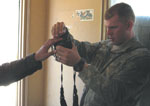Friend Or Foe?
 |
| U.S. soldiers in Southwest Asia are using the Handheld Interagency Identification Detection Equipment (HIIDE) to identify friends and foes in the tactical environment. The devices include iris, fingerprint and facial modalities. |
The U.S. Army is distributing and supporting small biometrics tools to aid troops in their ability to identify persons of interest and allies in
Tobyhanna personnel are working with deployed soldiers on the operation of Handheld Interagency Identification Detection Equipment (HIIDE)—portable, self-contained systems used in the field for the tactical identification of all persons. The handheld devices contain software with the ability to collect biometrics information on thousands of persons. The multimodality, enroll-and-identify capabilities include tools for iris, facial and fingerprint collection and matching. George Bellas, director of the Command, Control, Computers (C3)/Avionics Directorate at Tobyhanna, explains that iris recognition is the most crucial feature to ensure correct identification. “That is the sure, positive way to prove who that person of interest is,” he shares.
Soldiers using the devices in the field can input biometric data from allies into HIIDE and then compare the information against individuals to ensure that people are whom they claim to be. Images of both irises, the face and 10 fingerprints from each person are collected and included in HIIDE. Biographical data accompanies the biometrics data, and all the information is stored in a database.
As part of the HIIDE technical support, Tobyhanna personnel swap out failed components, conduct operations testing, offer training and provide other technical assistance. If one of the devices fails totally, personnel send it back to the manufacturer, SecuriMetrics, to replace it with a new one. Tobyhanna has six in-country locations from which support personnel move out to other locations to disperse or service equipment.
Not everyone who supports the HIIDE mission for Tobyhanna travels to forward operating areas. Some remain at the six established sites in
Repair work generally entails replacing defective components, because the current rate of mass production makes replacing HIIDE devices with major problems more economical than mending them in many cases. “I tell everyone, ‘Look at your cell phone,’” Bellas says. “‘If it went bad, would you send it out to get fixed or would you throw it away?’” He adds that other major military programs, such as the Single Channel Ground and Airborne Radio System, also comprise mostly throw-away parts. In some cases, programs evolve to a point where certain expensive pieces are better to repair than replace, but Bellas is unsure whether that will be the case with HIIDE. He shares that the important thing is to keep HIIDE devices functioning and keep the system working so soldiers can use it to meet mission requirements.
Though keeping the units operational is important, the majority of the current work conducted by Tobyhanna personnel is handing off the devices, ensuring troops are technically proficient on HIIDE and teaching them what to do if the system fails to operate correctly. Bellas explains that if Tobyhanna personnel only distributed the devices, without providing training, the number of returns would be significantly higher. By tutoring users on the equipment, Tobyhanna personnel reduce the number of service calls necessary to keep everything operational. “It’s more of a handoff and training,” he shares. When the support personnel are called in for a problem, they make a decision on how best to resolve the issue. If a component in a device fails, Tobyhanna personnel replace that part. If the entire tool fails, they send it back.
 |
| A U.S. soldier employs HIIDE. The equipment shipped to deployed troops allows soldiers to enter data on new personnel. |
Despite the use of HIIDE in
As more information about the use of HIIDE becomes available, the military may decide to enhance the product with upgrades. If a leadership organization makes that decision, Project Manager (PM) Biometrics would reach out to Tobyhanna with the update and ask for assistance from depot personnel. Bellas assumes that will happen in the future, but does not know when or even if it will occur. Tobyhanna performs resets for other systems where equipment has been in the field for a long period and then is brought to the depot, reset and sent back to deployed locations.
Most information on HIIDE, including the total number of units in the field and who is using them, is classified. However, Richard Sokoloski, project officer for deployment for C3/Avionics Forward Repair Activity, says “not that many” are in operation, and the devices are not given to individuals but to groups of soldiers.
After Tobyhanna field personnel distribute the HIIDE devices and look over the shoulders of the soldiers to make sure they are using the tools correctly, they move on to another group. If troops need help troubleshooting or operating the devices later, they can contact the Tobyhanna personnel for assistance. Bellas explains that, “When we’re out there, they get our cell phone numbers real quick.” He adds that Tobyhanna has a good communications system in
Just as the number of units in theater is sensitive information, so is the number of Tobyhanna personnel deployed to support them, although Bellas does say the number fluctuates frequently. Bellas and Sokoloski both emphasize that Tobyhanna employees are excited to be performing the work because of its cutting-edge nature. “That’s enough for interest,” Sokoloski shares. Bellas adds that individuals interested in high-tech devices “eat this stuff up.”
The depot personnel are performing the distribution and support of HIIDE at the request of PM Biometrics. However, the equipment does not fall under that project manager, but is the responsibility of the Army Space Program Office. At this time, the Army is the only service using the equipment. In addition to HIIDE, Tobyhanna is supporting more biometrics efforts at the request of PM Biometrics. HIIDE is only one part of the larger biometrics effort that includes the Biometric Identification System for Access (BISA) and the Biometric Automated Toolset. PM Biometrics has control and responsibility for those two efforts. According to Bellas, the depot will serve as a systems integrator for BISA, which is used more in security environments, such as when visitors pass through a military gate.
HIIDE is the first step into BISA. The information from the devices eventually will be placed on smart cards through the system for access, and personnel will present the cards for access to facilities, basically serving as a common access card for non-U.S. entities.
PM Biometrics already is funding Tobyhanna for work on BISA. The effort began in fiscal year 2008 and will continue through fiscal year 2009. Unlike HIIDE, which involves small, self-contained devices, BISA requires more and larger hardware. Although Tobyhanna already has possession of BISA, at this point, the depot personnel’s work with the system only extends to having received training. Future work includes testing all the equipment and distributing it to warfighters.
Web Resources
Tobyhanna Army Depot: www.tobyhanna.army.mil
SecuriMetrics/HIIDE Specifications: www.securimetrics.com/solutions/hiide.html
Project Manager Biometrics: www.eis.army.mil/DodBiometrics.asp
Army Space Program Office: www.aspo.army.mil




Comments